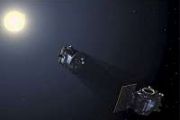
Copernical Team
NASA's Mars Sample Return mission is in trouble—but it's a vital step to sending humans to the red planet
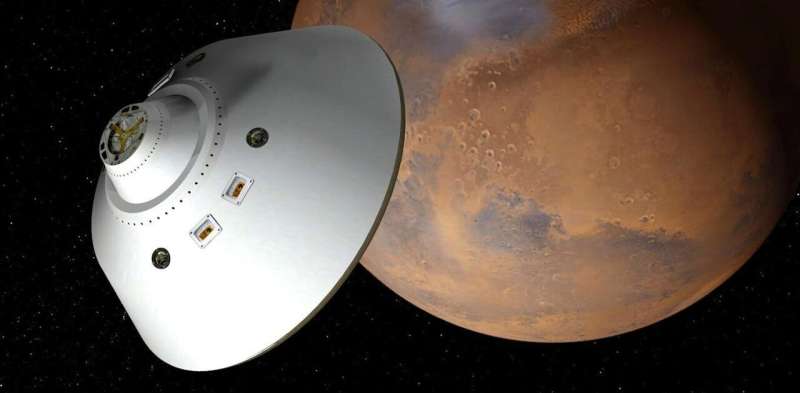
NASA recently asked the scientific community to help come up with innovative ideas for ways to carry out its Mars Sample Return (MSR) mission. This was in response to a report by an independent board that deemed that its US$11 billion (£8.7 billion) price tag was too expensive and its 2040 timeline too far in the future.
In brief, the ambitious plan was to collect rock samples cached inside containers by NASA's Perseverance rover and deliver them to laboratories on Earth. Perseverance has been exploring Mars' Jezero Crater, thought to have once hosted an ancient lake, since 2021. The mission would deliver the samples by sending a lander that carries a rocket (NASA's Sample Retrieval Lander) down to the surface of Mars.
Perseverance would then deliver the cached rock samples to the lander, with small drone helicopters delivered on the lander as a back up. Perseverance's samples would then be launched into Mars' orbit using the lander's rocket. A spacecraft already in Martian orbit, the Earth Return Orbiter, would then intercept these samples and deliver them to Earth.
Chinese astronauts return to earth after six months in space
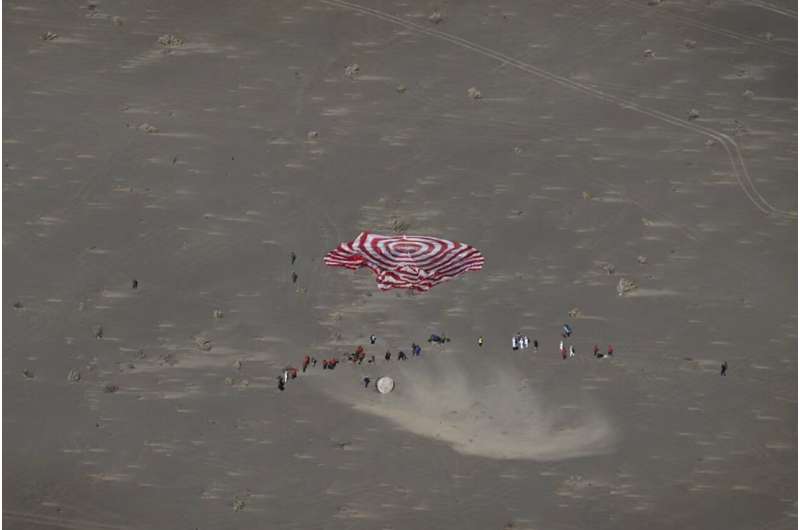
Ariane 6 gets its wings
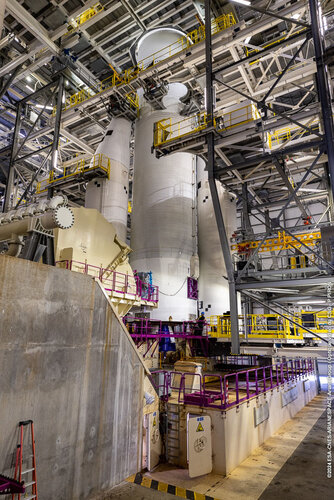 Image:
Ariane 6's boosters are connected to the rocket's central core
Image:
Ariane 6's boosters are connected to the rocket's central core Smiles all round: Vega-C to launch ESA solar wind mission
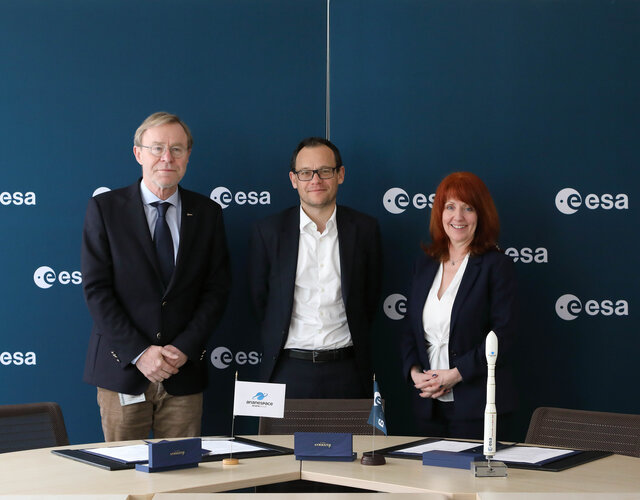
ESA ensures a ride into space for its Smile mission, with Arianespace signing up to launch the spacecraft on a Vega-C rocket
Galileo satellite constellation expands with two new additions
 The Galileo navigation system has expanded its constellation with the addition of two new satellites, launched early on Sunday, 28 April, at 01:34 BST/02:34 CEST. This latest expansion brings the total to 30 satellites, enhancing Galileo's capabilities in terms of reliability, robustness, and precision, which benefits billions of global users.
Galileo, operational since 2016 and recognized
The Galileo navigation system has expanded its constellation with the addition of two new satellites, launched early on Sunday, 28 April, at 01:34 BST/02:34 CEST. This latest expansion brings the total to 30 satellites, enhancing Galileo's capabilities in terms of reliability, robustness, and precision, which benefits billions of global users.
Galileo, operational since 2016 and recognized ESA advances two Thales Alenia Space AI projects for Fsat-2 orbital tests
 The European Space Agency (ESA) has chosen Thales Alenia Space's IRMA and PhiFireAI projects for in-orbit testing aboard the Fsat-2 microsatellite. Scheduled for a June 2024 launch, this 6U CubeSat will explore how artificial intelligence (AI) can enhance Earth observation satellites to address social, economic, and environmental issues.
Initiated in early 2023, the ESA's challenge involve
The European Space Agency (ESA) has chosen Thales Alenia Space's IRMA and PhiFireAI projects for in-orbit testing aboard the Fsat-2 microsatellite. Scheduled for a June 2024 launch, this 6U CubeSat will explore how artificial intelligence (AI) can enhance Earth observation satellites to address social, economic, and environmental issues.
Initiated in early 2023, the ESA's challenge involve China's rocket engine test sets new thrust record
 China Aerospace Science and Technology Corp, the country's key space contractor, conducted a critical test on Sunday on a new type of rocket engine, achieving the highest thrust power ever achieved in tests of Chinese liquid-propellant engines.
The test involved a combined ignition of four engines at an engine testing facility in Fengxian county, Shaanxi province. These engines were connec
China Aerospace Science and Technology Corp, the country's key space contractor, conducted a critical test on Sunday on a new type of rocket engine, achieving the highest thrust power ever achieved in tests of Chinese liquid-propellant engines.
The test involved a combined ignition of four engines at an engine testing facility in Fengxian county, Shaanxi province. These engines were connec Rocket Lab schedules dual launches for NASA's climate satellite missions
 Rocket Lab USA, Inc. (Nasdaq: RKLB) is gearing up for two consecutive Electron rocket launches to deploy satellites for NASA's Polar Radiant Energy in the Far-InfraRed Experiment (PREFIRE) mission.
The company plans to launch the satellites into a 525km circular orbit from its Launch Complex 1 in Mahia, New Zealand. The initial mission, dubbed 'Ready, Aim, PREFIRE,' is slated for no earli
Rocket Lab USA, Inc. (Nasdaq: RKLB) is gearing up for two consecutive Electron rocket launches to deploy satellites for NASA's Polar Radiant Energy in the Far-InfraRed Experiment (PREFIRE) mission.
The company plans to launch the satellites into a 525km circular orbit from its Launch Complex 1 in Mahia, New Zealand. The initial mission, dubbed 'Ready, Aim, PREFIRE,' is slated for no earli Redefining engineering practices across NASA
 Since John F. Kennedy's landmark 1961 address advocating for lunar exploration, NASA has continually embraced the challenge of difficult endeavors to stimulate innovation across its varied missions. Kennedy articulated this ethos when he said, "We choose to go to the Moon not because it's easy, but because it's hard; because that goal will serve to organize and measure the best of our energies a
Since John F. Kennedy's landmark 1961 address advocating for lunar exploration, NASA has continually embraced the challenge of difficult endeavors to stimulate innovation across its varied missions. Kennedy articulated this ethos when he said, "We choose to go to the Moon not because it's easy, but because it's hard; because that goal will serve to organize and measure the best of our energies a PREFIRE mission will analyze polar energy exchanges
 NASA, in collaboration with Rocket Lab, has scheduled the first launch for the PREFIRE (Polar Radiant Energy in the Far-InfraRed Experiment) mission on Wednesday, May 22, 2024. The mission aims to enhance our understanding of polar energy dissipation and its implications on global climate dynamics.
The launch from Launch Complex 1 in Mahia, New Zealand, marks the beginning of a series of t
NASA, in collaboration with Rocket Lab, has scheduled the first launch for the PREFIRE (Polar Radiant Energy in the Far-InfraRed Experiment) mission on Wednesday, May 22, 2024. The mission aims to enhance our understanding of polar energy dissipation and its implications on global climate dynamics.
The launch from Launch Complex 1 in Mahia, New Zealand, marks the beginning of a series of t 






























